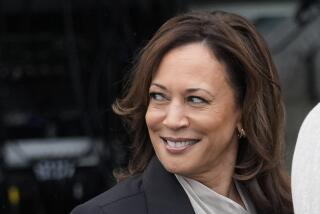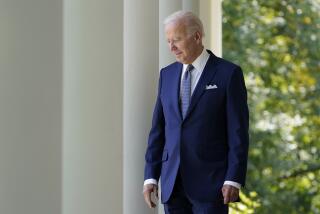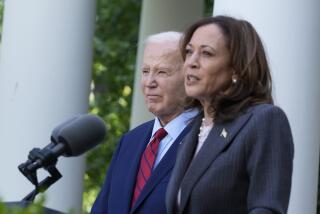On abortion, Joe Biden decides it’s better to switch than fight
Reporting from Washington — Joe Biden managed to get six weeks into his campaign for the 2020 presidential nomination without a major controversy, but when he hit one Wednesday, it was big.
On the surface, the issue was abortion. Underneath, however, the real question was the one that has hovered over his candidacy from Day 1: Can Biden, a politician formed in the mid-20th century, truly lead the Democratic Party of the 21st century?
To try to show that he can, Biden jettisoned a position he has held for four decades. Only a day after his campaign said he continued to oppose the use of federal money to pay for abortions, Biden personally announced Thursday that he had changed his mind.
Sign up for the Essential Politics newsletter »
INSURANCE MADNESS
We’ll get back to Biden in moment, but first, if you haven’t already read Noam Levey’s excellent series on how high-deductible health insurance policies have driven hundreds of thousands of people into bankruptcy or despair, take a few minute to catch up.
The latest installment in the series examines how the combination of soaring deductibles and rising drug prices has hit sick Americans with a “double whammy,” bringing on financial ruin and worsening illnesses and, in some cases, costing lives.
HE CAN RUN, BUT HE CAN’T HYDE
Biden entered the U.S. Senate in 1973, just a few months before the Supreme Court, in Roe vs. Wade, legalized abortion nationwide.
Three years later, in one of the first major victories for the anti-abortion movement, Congress approved the so-called Hyde Amendment, prohibiting the use of Medicaid funds to pay for most abortions. Biden supported the restriction then and continued to do so until Thursday night.
While the late Rep. Henry Hyde (R-Ill.) was a leader of the anti-abortion cause, the restriction that bears his name drew support for years from a much broader swath of opinion. Backers argued that in a country with a wide divergence of views on abortion, taxpayers should not be forced to pay for a procedure that many regard as immoral.
In recent years, however, an opposing view has gained strength: The restriction reinforces inequality because Medicaid and other federal programs covered by the amendment mostly serve poor women. Disproportionately, those women are also nonwhite.
As Democrats have increasingly relied on the support of younger, nonwhite voters, the party turned against Hyde.
That shift is just one of the areas in which the Democrats have moved to the left. A major issue for Biden has been how much he will have to shift to match where the party now stands.
Earlier in the week, Biden pleasantly surprised many environmental activists by releasing an ambitious plan to combat global warming. As Evan Halper and Janet Hook wrote, the position he took was distinctly not the “middle ground” approach that some advisors had forecast.
But if Biden’s strategists thought they could balance a left-leaning position on the environment with a more centrist stand on abortion, they clearly miscalculated.
As Hook and Jennifer Haberkorn reported, Biden’s announcement on Wednesday that he still supported the Hyde rule, stunned and dismayed many Democrats.
“I’m kind of astonished,” said Rep. Jackie Speier of Hillsborough.
The issue shined a harsh light on Biden’s record, reminding Democratic activists about all the other positions he has taken over the years that don’t match current party stands.
With abortion rights groups in open revolt, Biden quickly reversed course, saying, first at a Democratic Party meeting in Atlanta and then on Twitter, that the current conservative assault on abortion rights had prompted him to reconsider.
“Women’s rights and healthcare are under assault in a way that seeks to roll back every step of progress we’ve made over the last 50 years,” he said. “If I believe healthcare is a right, as I do, I can no longer support an amendment that makes that right dependent on someone’s ZIP Code.”
Of course, all that was true on Wednesday, too.
Republicans quickly went on the attack, hitting one of their main themes against him — that Biden isn’t the centrist he claims to be but is, instead, a captive of the left.
For Biden, however, Republican reaction is a problem for another day. For now, the question is how much damage he has sustained in his own party, either from initially trying to flout its orthodoxy or from so rapidly dropping a position he had long portrayed as one of principle.
One controversy almost eight months before the first primary voting is hardly going to sink a candidacy. But this week’s fight served as a reminder, if one was needed, that Biden’s front-runner status isn’t locked in place. He was able to float above the fray for a time, but he’s down in it now.
THE AMERICAN TOURIST
President Trump spent the week in Europe, dining with Queen Elizabeth II, speaking at a D-day commemoration and checking the accommodations at his golf club in Ireland.
The D-day anniversary speech has been a staple event for U.S. presidents for decades. President Reagan used his turn at the 40th anniversary to give one of his greatest speeches. A quarter-century later, President Obama delivered a memorable meditation on war and sacrifice.
On this week’s 75th anniversary, Trump’s speech was workmanlike, but doomed to be overshadowed by everything else he did.
As Eli Stokols wrote, even amid the pomp and ceremony, Trump kept his attention focused on his own opponents, domestic and foreign.
Trump started the trip by insulting Meghan Markle, the American-born wife of Prince Harry, calling her “nasty” during an interview with the Sun tabloid.
He tried to deny that he used the word until the Sun produced a tape of him saying it. He then switched defenses, telling his longtime friend, Piers Morgan, in an interview that he meant only to rebuke a remark Markle had made in 2016 that criticized him, not to comment on her in general.
Meanwhile, he engaged in a running feud with Sadiq Khan, the mayor of London, was flummoxed in Britain by a question about that country’s National Health Service and kicked up a controversy in Ireland with a few ill-chosen words about border walls.
On the D-day anniversary, before speaking at the American cemetery in Normandy, he sat for an interview with Fox News personality Laura Ingraham in which he attacked House Speaker Nancy Pelosi (D-San Francisco), calling her “nasty,” “vindictive” and “horrible.”
One thing Trump did not do, as Stokols noted, was assert leadership over the various right-wing populist movements that have shaken up politics in Europe and elsewhere. He’s just not that interested.
Some of Trump’s supporters like the fact that he’s a fighter. Polls show, however, that most Americans abhor his tendency to quarrel. For both groups, Trump’s visit to see the queen lived up to expectations.
MEANTIME, BACK HOME
All week, Mexican officials fanned out across Washington, trying to find a way to avert Trump’s threat to impose escalating tariffs on that country’s exports unless it takes unspecified action to block migrants from traveling through its territory to the U.S.
The Mexican delegation, led by Foreign Minister Marcelo Ebrard, argued that tariffs would hurt both countries’ economies, as Tracy Wilkinson wrote. The Mexicans picked up significant support on Capitol Hill, where Senate Republicans made clear that they did not support a sudden tax increase on businesses that import goods across the southern border.
On Wednesday, Ebrard and his delegation met at the White House with Vice President Mike Pence, Secretary of State Michael R. Pompeo and other officials.
“Progress is being made. But not nearly enough!” Trump tweeted after the meeting ended.
As the talks continued Thursday, the Mexican authorities were cracking down on migrant groups in their country, Kate Linthicum, Patrick McDonnell and Wilkinson reported. But no one could say whether the crackdown — and the promises of further enforcement steps to come — would be enough to persuade Trump to drop the tariff plan, which is supposed to take effect Monday.
A senior administration official on Wednesday told Noah Bierman that Trump would almost surely go ahead with the tariffs, if only for a few days, to prove he wasn’t bluffing.
“He wants to not use blanks,” the official said.
Both sides have incentive to compromise, however.
Trade is one area in which Republicans have proved a willingness to buck Trump, and the president faces a real possibility that Congress could vote to curtail his power if he persists.
He also has to worry that a trade war with Mexico, on top of the existing one with China, might tip the economy into recession. That concern may have deepened with this morning’s mediocre report on the number of new jobs created in the past month.
Mexico’s government, too, has serious economic worries. The peso is already weak, and the threat of a fight with Trump has worsened its standing.
Talks are expected to continue into the weekend.
THE ASYLUM PUZZLE
The border problem that has enraged Trump mostly involves people from Central America who claim they face persecution in their home countries, which suffer from catastrophic levels of violence. When they get to the U.S., they readily surrender to border guards and ask for asylum, which at least guarantees them a hearing under U.S. law.
But Central America is not the only source of asylum claims. As Molly O’Toole reported, Venezuela, is now a top source of people asking for U.S. asylum, and that poses a challenge for Trump. The administration regards the government of Venezuela’s leader, Nicolas Maduro, as a dictatorship that oppresses its people. At the same time, Trump wants to shut off asylum.
Hundreds of thousands of Venezuelans are caught in the middle, and the flood of people is likely to accelerate as conditions there get worse.
CALIFORNIA DREAMING
Fourteen Democratic presidential candidates landed in San Francisco this past weekend to speak at the state party convention. As Melanie Mason and Mark Barabak wrote, the turnout vividly showed that California isn’t a campaign afterthought this election cycle. The state’s early primary on March 3 makes it a pivotal part of the campaign action.
Hopes of winning a chunk of California delegates are enough to even bring candidates to the Central Valley, Mason and Michael Finnegan wrote. There, for example, was Mayor Pete Buttigieg, getting an opportunity in Fresno to show off his command of Spanish — one of several languages he speaks.
“Our communities are forgotten,” the South Bend, Ind., mayor told a potential supporter.
Barabak also looked at a key nationwide voting bloc for Democrats: African Americans. For many, he found, 2020 is all about beating Trump, even if that means choosing a white, male nominee.
TO IMPEACH OR NOT?
Pelosi continues to try to hold back those in her party who want to move to impeach Trump. One reason: House Democrats don’t have a majority for impeachment currently, Haberkorn and Sarah Wire wrote.
Support is growing, however, for starting a formal impeachment inquiry. We assessed where each member of the California Democratic delegation stands on that question.
REMEMBER MITT?
Republican Sen. Mitt Romney of Utah gave his first formal Senate floor speech this week. Its main topic was China’s rise to power, but as Caroline Engelmayer wrote, a clear subtext was criticism of Trump.
THE SUPREME COURT FINALE
The Supreme Court is heading into the final few weeks of its term, the period when all the tough cases get resolved. David Savage has a rundown of what’s coming, with disputes over political power — gerrymandering and the census — at the top of the list.
LOGISTICS
That wraps up this week. Until next time, keep track of all the developments in national politics and the Trump administration at our Politics page and on Twitter @latimespolitics.
Send your comments, suggestions and news tips to politics@latimes.com.
If you like this newsletter, tell your friends to sign up.
More to Read
Get the L.A. Times Politics newsletter
Deeply reported insights into legislation, politics and policy from Sacramento, Washington and beyond. In your inbox three times per week.
You may occasionally receive promotional content from the Los Angeles Times.











